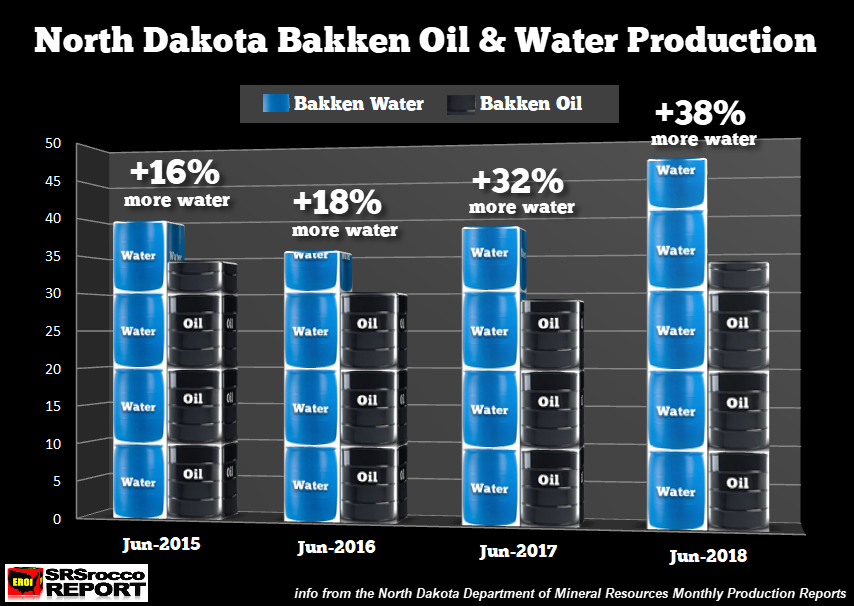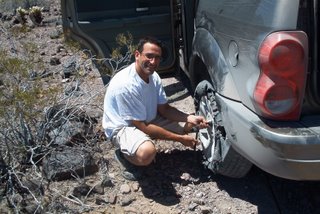Page added on August 19, 2018
BIG TROUBLE BREWING AT THE BAKKEN: Rapid Rise In Water Production Signals Red Flag Warning

Big trouble is brewing in the mighty North Dakota Bakken Oil Field. While oil production in the Bakken has reversed since it bottomed in 2016 and increased over the past few years, so has the amount of by-product wastewater. Now, it’s not an issue if water production increases along with oil. However, it’s a serious RED FLAG if by-product wastewater rises a great deal more than oil.
And… unfortunately, that is exactly what has taken place in the Bakken over the past two years. In the oil industry, they call it, the rising “Water Cut.” Furthermore, the rapid increase in the amount of water to oil from a well or field suggests that peak production is at hand. So, now the shale companies will have an up-hill battle to try to increase or hold production flat as the water cut rises.
According to the North Dakota Department of Mineral Resources, the Bakken produced 201 million barrels of oil in the first six months of 2018. However, it also produced a stunning 268 million barrels of wastewater:

Thus, the companies producing shale oil in the Bakken had to dispose of 268 million barrels of by-product wastewater in just the first half of the year. I have spoken to a few people in the industry, and the estimate is that it cost approximately $4 a barrel to gather, transport and dispose of this wastewater. Which means, the shale companies will have to pay an estimated $2.2 billion just to get rid of their wastewater this year.
Now, some companies may be recycling their wastewater, but this isn’t free. Actually, I have seen estimates that it cost more money to recycle wastewater than it does to simply dispose of it. So, as the volume of wastewater increases while the percentage of oil production declines, then the shale companies are hit with a double-whammy… less oil revenue and rising wastewater disposal costs.
To give you an idea just how much more water is being produced versus oil in the Bakken, I went back to the North Dakota Department of Mineral Resources and looked at their data back to 2015. Unfortunately, the data published in excel only goes back to 2015, even though they have figures published in PDF form starting in 2003.
Regardless, four years is plenty of time to show just how bad the situation is becoming in the Bakken. In June 2015, the North Dakota Bakken produced 16% more water than oil. However June this year, the Bakken field produced 38% more water than oil:

You will notice that overall oil and water production declined in 2016, due to the falling oil price, but as production grew in 2017 and 2018, the percentage increase of by-product wastewater surged to 32% and 38% respectively. Here is an interesting comparison:
Bakken Oil & Water Production:
June 2015 Oil = 34.4 million barrels
June 2015 Water = 39.8 million barrels (16% more water)
June 2018 Oil = 33.8 million barrels
June 2018 Water = 46.8 million barrels (38% more water)
As we can see, while overall Bakken oil production in June 2018 was less than it was in June 2015, the volume of waster water increased by an additional 7 million barrels.
I believe there are two negative forces at work in the Bakken as it pertains to the rising volume of wastewater.
- As the wells and field age, more water is produced than oil
- Larger Frac Stages, which require more water and sand, are now being utilized to keep production growing or to keep it from falling
While a rising water cut isn’t a surprise to the industry as it is a natural progression of an aging oil well or field, the use of Larger Frac Stage wells should be a WAKE-UP CALL to investors. Why? Because Larger Frac Stage wells consume a great deal more water and sand to produce more oil initially, but the decline rates are even more severe than regular shale wells.
So, when the Investor Relations are bragging how the companies are using newer technology of more complex Large Frac Stage wells, this isn’t a good sign. This means that the company is now desperate to try and grow production, or at worst, to keep it from falling.
Unfortunately, the U.S. Shale Industry is in serious trouble. Most of the shale fields have reached a peak and when production starts to decline, especially during a collapsing oil price, I forecast a rapid disintegration of the industry. We must remember, as the oil price and oil production falls, then company stock and asset values will plummet while the high debt levels remain. Thus, the shale industry will have increasing difficulty in servicing its debt.
I will continue to monitor the production of oil and wastewater in the Bakken. Please check back for updates.
65 Comments on "BIG TROUBLE BREWING AT THE BAKKEN: Rapid Rise In Water Production Signals Red Flag Warning"


makati1 on Sun, 19th Aug 2018 4:23 pm
Dream on Boat. You will be walking by 2025 at the latest. The US is oil DEPENDENT. If it has to sell oil that it cannot use because of no ability to refine it, then that is not counted as usable oil. It has to be exported. If trade stops, no one will want that oil. Then what?
If you are sucker enough to believe all of the bullshit spewed out by the oily industry and the EIA, then you deserve to lose it all. LOL
MASTERMIND on Sun, 19th Aug 2018 4:24 pm
Clogg
Former head of EIA
2020s To Be A Decade of Disorder For Oil
https://oilprice.com/Energy/Energy-General/2020s-To-Be-A-Decade-of-Disorder-For-Oil.html
MASTERMIND on Sun, 19th Aug 2018 4:24 pm
In nature, the over – extension of a population upon a resource which diminishes is well known, and the results tend to be disastrous..
-Youngquist
MASTERMIND on Sun, 19th Aug 2018 4:38 pm
Boat
If Fracking can’t make a profit in a few years they are going to go bankrupt..Investors won’t keep funding them forever and when they peak they will likely stop..
MASTERMIND on Sun, 19th Aug 2018 6:57 pm
London workers are queuing up for free food because they can’t afford to eat
https://www.independent.co.uk/news/uk/home-news/workers-jobs-food-banks-money-afford-cost-living-a8494311.html
I though Capitalism never caused breadlines?
twocats on Sun, 19th Aug 2018 7:59 pm
Every person, every company, every town, every country, every oil field, just trying to get through another week, another day. the strain at this point on the system is almost beyond belief.
normally at this point the ruling class groups would help facilitate some sort of organized, coordinated step-down. but the infighting has reached a tipping point, and no one believes the system can survive another downturn.
so it might be full steam ahead. that means water cut in the bakken – blah, blah, blah. can you get to 1.6 mbpd? that’s what I need people. doubling down on 1.6 mbpd MINIMUM. Really would rather see AVERAGE 1.6 mbpd, but fuck it, we can live with 1.6 by EOY
MASTERMIND on Sun, 19th Aug 2018 8:28 pm
French bridges ‘at risk of collapse’
More than 800 road bridges in France are at risk of collapsing within a few years, according to a survey carried out for the Transport Ministry that has raised alarm following the Genoa tragedy.
https://www.telegraph.co.uk/news/2018/08/18/french-bridges-risk-collapse/
makati1 on Sun, 19th Aug 2018 9:04 pm
Missouri in the news: “…the 10 most-traveled structurally deficient bridges in America. All of them are in either California or Missouri…”
https://www.zerohedge.com/news/2018-08-17/could-genoa-disaster-happen-us
Slip slidin’… or is it CRASH!?
Dooma on Sun, 19th Aug 2018 9:44 pm
Could someone (Rockman?) or anybody else who knows about the process, please elaborate on where/how the waste-water is disposed or cleaned, please?
deadly on Sun, 19th Aug 2018 10:24 pm
Salt Water Disposal Wells
There are currently 430 Active SWD wells in North Dakota
• There are currently 133 Commercial SWD wells in North Dakota
• There are currently 10 Approved SWD wells that have not been drilled
• There are currently 16 SWDs that have Confidential Status
• There are currently 25 Permits Pending Approval
Simon Rodgers on Mon, 20th Aug 2018 4:34 am
MM :- The Telegraph is only marginally better than the Daily mail, just FYI
rockman on Mon, 20th Aug 2018 11:38 am
MM – “You cited no evidence…”. I did state the evidence: simple logic supported by even more simple arithmetic. Two aspects it appears beyond just you and no one else here. As pointed out by another posted: it is inevitable for all trends…called depletion.
Permavillage on Mon, 20th Aug 2018 7:39 pm
Wherever we look, it is only pollution, pollution, pollution
Blow Your Energy 😉
rockman on Tue, 21st Aug 2018 12:44 pm
deadly – Thanks for the numbers. Strikes me as a lot of commercial disposal operations. Perhaps why operating costs are high: not enough oil/water production on individual leaseholds to justify a dedicated disposal well for those small number of wells. The fee paid to the commercial well owner might be a little as $.50/bbl but hauling it there could run $4 to $6 per bbl.
rockman on Tue, 21st Aug 2018 12:49 pm
The model I presented to MM was one of very simple linear progression. He’s the only one that seems to have trouble understanding it. I could explain in a little more detail if someone wishes it. Otherwise I won’t waste the space just for MM.